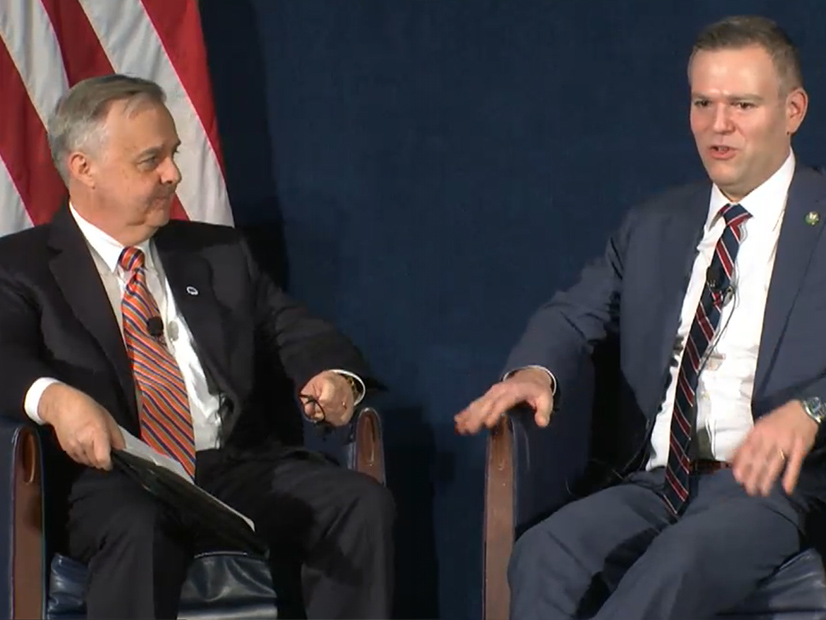FERC Commissioner David Rosner hopes that the rehearing order on Order 1920 will win broader support than the 2-1 split vote that produced the original.
Speaking at the WIRES Fall Member Meeting, Rosner said that based on the comments in the docket and discussion with his colleagues, many stakeholders agree on some modest changes to the original that are still in line with its intent to expand the transmission grid.
“I’m really hopeful that we can get five votes on a rehearing order, but I don’t know, we’ll see what happens,” Rosner said. “I mean, all I can really guarantee is one vote, but I’m committed to work through that.”
One area Order 1920 did not address much was interregional transmission, Rosner said, adding that he would be happy to implement anything Congress manages to pass. Expanded authority over interregional transmission is part of the Energy Permitting Reform Act that cleared the Senate Energy and Natural Resources Committee this summer and could move forward in a lame duck session after the election. (See Manchin-Barrasso Permitting Bill Easily Clears Committee.)
NERC CEO Jim Robb’s argument at the recent FERC reliability technical conference that interregional transmission can help the grid deal with emerging issues resonated with Rosner, he said. (See FERC Grills Grid Stakeholders on Reliability.)
“I think interregional is really important,” Rosner added. “I also don’t have any updates on commission action on that, but I will leave it at, I think it’s really important. … We have a good record open already on this, and we have lots to think about.”
Supply Chain’s Impact on the Grid
While FERC has plenty of work to do on its own to ensure grid reliability, some issues largely fall outside of its purview, which includes supply chain disruptions, such as during the COVID-19 pandemic, noted Hailey Siple, director of national security policy for the Edison Electric Institute.
The first weeks of the pandemic were some of the busiest of Siple’s career, she said, as she had to work to help manage the industry’s response.
“While we were doing that, that is the first time that I remember really sitting down and thinking about supply chain, the energy supply chain in particular, as a national security threat,” Siple said. “And I think the conversation changed very much at that point. So, we had really no immediate impacts those first couple weeks or months, but a few months down the road, we had first one of our chief procurement officers come and say, ‘Hey, we’re seeing some long lead times.’”
EEI started to hear from more and more of the industry that the pandemic was stretching supply lines thin, so it started working to help address the issue along with the rest of the industry and the Department of Energy.
“There is a fantastic relationship between industry and not just EEI, but all segments of the industry, and the Department of Energy through the Electricity Subsector Coordinating Council,” Siple said. Once the worries about the supply chain were known, ESCC set up a team to work on the issues, she recalled.
Now DOE itself has set up its Office of Manufacturing and Energy Supply Chains to help coordinate the issue, said its chief strategy officer, Arthur Haubenstock.
“A good chunk of what we are programming is in transmission, because it is the lifeblood of our energy system, and will increasingly be so as we work on industrial decarbonization, which is another area that our office is responsible for,” he added.
The need to get energy supply chains right will also be important to deal with the strains being placed on the grid, whether it is from climate change or increased demand, Haubenstock said.
Increased demand from data centers, and the utilities looking to plug them into the grid, has been a huge change for Siemens Energy, one of the main suppliers of electric transmission infrastructure, said Anthony Zito, the company’s director of sales operations.
Customers are increasingly aware of the strains and trying to book equipment a decade ahead of time for sites that are not even on the drawing board now, Zito said. But with the need for data centers, the equipment will definitely be used.
“We had one data center customer that, four years ago, we were the sole supplier to them globally,” Zito said. “We now can’t serve more than 20% of what they say their need is for the next couple years.”
Demand is so high, some data center developers and utilities have approached Siemens to buy out all its capacity for the next five or 10 years, he added. The firm has declined such offers because of the risk that a single customer’s business plans could change.
“What happens if they go bankrupt, or they decide they’re not building anymore, and now you’ve alienated every other customer, every other utility, data center customer, renewable customer?” Zito said. “So, we look at sort of a mitigation strategy to spread the love around.”



